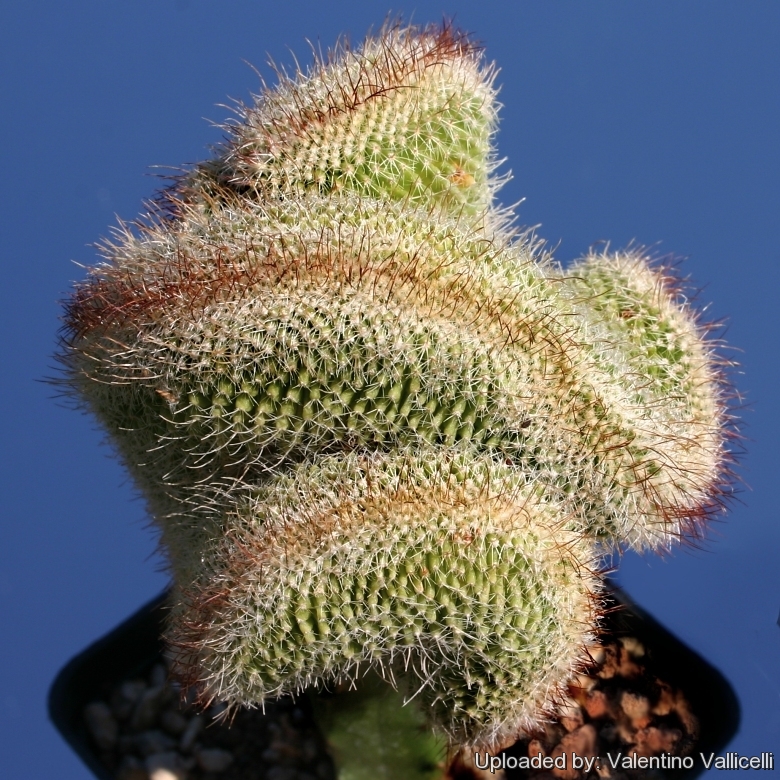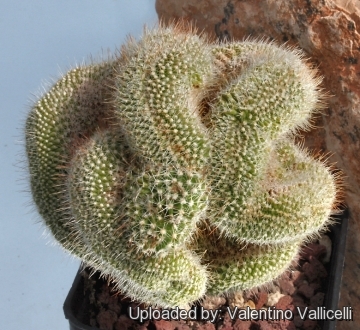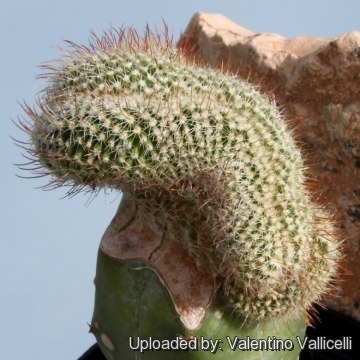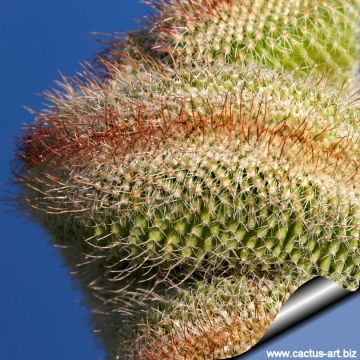




Your support is critical to our success.
Accepted Scientific Name: Stenocactus crispatus
Kakteen (Berger) 346. 1929

Origin and Habitat: Garden origin ( produced cultivar)
Synonyms:
Stenocactus crispatus (DC.) A.Berger
Kakteen (Berger) 346. 1929
Synonymy: 111
- Stenocactus crispatus (DC.) A.Berger
- Brittonia crispata (DC.) Speg.
- Brittonrosea crispata (DC.) Speg.
- Echinocactus crispatus DC.
- Echinocactus undulatus A.Dietr.
- Echinofossulocactus crispatus (DC.) Lawr. in Loudon
- Efossus crispatus (DC.) Orcutt
- Ferocactus crispatus (DC.) N.P.Taylor
- Stenocactus acroacanthus (D.C.Stieber) W.T.Marshall & T.M.Bock
- Echinocactus acroacanthus D.C.Stieber
- Echinofossulocactus acroacanthus (D.C.Stieber) G.D.Rowley
- Echinofossulocactus crispatus f. acroacanthus (D.C.Stieber) P.V.Heath
- Stenocactus anfractuosus (Mart. ex Pfeiff.) A.Berger
- Brittonrosea anfractuosa Speg.
- Echinocactus anfractuosus Mart. ex Pfeiff.
- Echinofossulocactus anfractuosus (Mart. ex Pfeiff.) Lawr. in Loudon
- Echinofossulocactus crispatus f. anfractuosus (Pfeiff.) P.V.Heath
- Efossus anfractuosus Orcutt
- Stenocactus arrigens (Link ex A.Dietr.) A.Berger
- Brittonrosea arrigens Speg.
- Echinocactus arrigens Link ex A.Dietr.
- Echinofossulocactus arrigens (Link ex A.Dietr.) Britton & Rose
- Echinofossulocactus crispatus f. arrigens (Link ex A.Dietr.) P.V.Heath
- Echinofossulocactus obvallatus var. arrigens (Link ex A.Dietr.) J.Meyran
- Efossus arrigens (Link ex A.Dietr.) Orcutt
- Stenocactus arrigens f. cristatus hort.
- Stenocactus confusus (Britton & Rose) F.M.Knuth in Backeb. & F.M.Knuth
- Brittonrosea confusa Speg.
- Echinofossulocactus confusus Britton & Rose
- Echinofossulocactus crispatus f. confusus (Britton & Rose) P.V.Heath
- Efossus confusus (Britton & Rose) Orcutt
- Stenocactus crispatus f. cristatus hort.
- Stenocactus crispatus f. ensiferus (Lem.)
- Echinocactus anfractuosus var. ensiferus (Lem.) Salm-Dyck
- Echinocactus ensiferus Lem.
- Echinofossulocactus crispatus f. ensiferus (Lem.) P.V.Heath
- Stenocactus crispatus f. undulatus (A.Dietr.)
- Echinofossulocactus crispatus f. undulatus (A.Dietr.) P.V.Heath
- Stenocactus dichroacanthus (Mart. ex Pfeiff.) A.Berger ex Backeb. & F.M.Knuth
- Brittonrosea dichroacantha (Mart. ex Pfeiff.) Speg.
- Echinocactus dichroacanthus Mart. ex Pfeiff.
- Echinocactus dichroacanthus spinosior Monv. in Labour.
- Echinofossulocactus crispatus f. dichroacanthus (Mart.) P.V.Heath
- Echinofossulocactus dichroacanthus (Mart. ex Pfeiff.) Britton & Rose
- Efossus dichroacanthus (Mart. ex Pfeiff.) Orcutt
- Stenocactus fasciculatus hort.
- Stenocactus flexispinus hort.
- Echinocactus flexispinus Salm-Dyck non Engelm.
- Echinofossulocactus crispatus f. flexispinus (Salm-Dyck) P.V.Heath
- Echinofossulocactus flexispinus (Salm-Dyck) Bravo
- Stenocactus gladiatus (Link & Otto) A.Berger ex Backeb. & F.M.Knuth
- Brittonrosea gladiata (Link & Otto) Speg.
- Echinocactus gladiatus Link & Otto
- Echinocactus gladiatus intermedius Lem. in Labour.
- Echinocactus gladiatus ruficeps Lem. in Labour.
- Echinofossulocactus gladiatus (Link & Otto) Lawr. in Loudon
- Efossus gladiatus (Link & Otto) Orcutt
- Melocactus gladiatus Link & Otto
- Stenocactus grandicornis (Lem.) A.Berger ex Backeb. & F.M.Knuth
- Brittonrosea grandicornis (Lem.) Speg.
- Echinocactus grandicornis Lem.
- Echinocactus grandicornis var. fulvispinus Salm-Dyck
- Echinofossulocactus crispatus f. grandicornis (Lem.) P.V.Heath
- Echinofossulocactus grandicornis (Lem.) Britton & Rose
- Efossus grandicornis (Lem.) Orcutt
- Stenocactus phyllacanthus f. grandicornus hort.
- Stenocactus guerraianus f. cristatus
- Stenocactus hastatus (Hopffer ex K.Schum.) A.Berger
- Brittonrosea hastata (Hopffer ex K.Schum.) Speg.
- Echinofossulocactus hastatus (Hopffer ex K.Schum.) Britton & Rose
- Echinofossulocactus sulphureus f. hastatus (Hopffer ex K.Schum.) P.V.Heath
- Efossus hastatus (Hopffer ex K.Schum.) Orcutt
- Stenocactus lamellosus hastatus hort.
- Stenocactus kellerianus hort.
- Echinofossulocactus crispatus f. kellerianus (Krainz) P.V.Heath
- Echinofossulocactus kellerianus Krainz
- Stenocactus lamellosus (A.Dietr.) A.Berger
- Brittonrosea lamellosa (A.Dietr.) Speg.
- Echinocactus lamellosus A.Dietr.
- Echinocactus lamellosus var. fulvescens Salm-Dyck
- Echinofossulocactus crispatus f. lamellosus (A.Dietr.) P.V.Heath
- Echinofossulocactus lamellosus (A.Dietr.) Britton & Rose
- Efossus lamellosus (A.Dietr.) Orcutt
- Stenocactus lancifer (A.Dietr.) A.Berger ex Backeb. & F.M.Knuth
- Brittonrosea lancifera (A.Dietr.) Speg.
- Echinocactus lancifer A.Dietr.
- Echinofossulocactus crispatus f. lancifer (A.Dietr.) P.V.Heath
- Echinofossulocactus lancifer (A.Dietr.) Britton & Rose
- Efossus lancifer (A.Dietr.) Orcutt
- Stenocactus longispinus hort.
- Echinofossulocactus arrigens var. longispinus (Pechanek) hort.
- Echinofossulocactus dichroacanthus var. longispinus (Pechanek) hort.
- Echinofossulocactus longispinus Pechanek
- Stenocactus crispatus f. longispinus hort.
- Stenocactus multiareolatus Bravo
- Stenocactus violaciflorus (Quehl) A.Berger
- Brittonrosea violaciflora (Quehl) Speg.
- Echinocactus violaciflorus Quehl
- Echinofossulocactus crispatus f. violaciflorus (Quehl) P.V.Heath
- Echinofossulocactus violaciflorus (Quehl) Britton & Rose
- Efossus violaciflorus (Quehl) Orcutt
- Stenocactus dichroacanthus subs. violaciflorus (Quehl) U.Guzmán & Vázq.-Ben.
- Stenocactus dichroacanthus var. violaciflorus (Quehl) Bravo
- Stenocactus xiphacanthus (Miq.) hort., nov. comb. ined.
- Echinocactus xiphacanthus Miq.
- Echinofossulocactus xiphacanthus (Miq.) Backeb.
Description: The crested form of the Echinofossulocactus guerraianusSN|6238]]SN|6238]] (Stenocactus) deviate considerably from the typical form for having thinner and densely packaged spines, however the overall appearance depend on clones.
Stem: Fan shaped relatively thin (2-3 cm thick), to 20 (or more) cm broad, bright-green with woolly apex.
Ribs: Tuberculate.
Areoles: To 2-8 mm apart;
Radial spines: Usually 8, white to yellowish, basally brown; up to 1 cm long.
Central spine: 1, milky white to rusty-red approximately, 1-2 cm long;
Flowers: Unknown.
Subspecies, varieties, forms and cultivars of plants belonging to the Stenocactus crispatus group-complex
 Stenocactus anfractuosus (Mart. ex Pfeiff.) A.Berger: ( Stenocactus crispatus ? ) The plant found in cultivation are quite variable, and the dissimilarity among seedlings spination may be considerable.
Stenocactus anfractuosus (Mart. ex Pfeiff.) A.Berger: ( Stenocactus crispatus ? ) The plant found in cultivation are quite variable, and the dissimilarity among seedlings spination may be considerable. Stenocactus arrigens (Link ex A.Dietr.) A.Berger: The ribs are thin with very undulated or curled ridges. The plant found in cultivation are quite variable (same as Stenocactus crispatus)
Stenocactus arrigens (Link ex A.Dietr.) A.Berger: The ribs are thin with very undulated or curled ridges. The plant found in cultivation are quite variable (same as Stenocactus crispatus) Stenocactus arrigens f. cristatus hort.: Crested form.
Stenocactus arrigens f. cristatus hort.: Crested form.- Stenocactus confusus (Britton & Rose) F.M.Knuth in Backeb. & F.M.Knuth
 Stenocactus crispatus (DC.) A.Berger: It is a solitary plant closely covered with long spines and wavy ribs. This is a very variable species that now includes many form (previously considered independent species) with one form intergrading into another, creating a taxonomig nightmare.
Stenocactus crispatus (DC.) A.Berger: It is a solitary plant closely covered with long spines and wavy ribs. This is a very variable species that now includes many form (previously considered independent species) with one form intergrading into another, creating a taxonomig nightmare. Stenocactus crispatus f. cristatus hort.: crested form.
Stenocactus crispatus f. cristatus hort.: crested form. Stenocactus dichroacanthus (Mart. ex Pfeiff.) A.Berger ex Backeb. & F.M.Knuth
Stenocactus dichroacanthus (Mart. ex Pfeiff.) A.Berger ex Backeb. & F.M.Knuth Stenocactus fasciculatus hort.: Branched (or solitary) plant, up to 20 cm tall, 10 cm wide with long spines and wavy ribs. Cultivated form.
Stenocactus fasciculatus hort.: Branched (or solitary) plant, up to 20 cm tall, 10 cm wide with long spines and wavy ribs. Cultivated form. Stenocactus gladiatus (Link & Otto) A.Berger ex Backeb. & F.M.Knuth: This plant is characterized by large, wide and flat sword-shaped central spines.
Stenocactus gladiatus (Link & Otto) A.Berger ex Backeb. & F.M.Knuth: This plant is characterized by large, wide and flat sword-shaped central spines. Stenocactus grandicornis (Lem.) A.Berger ex Backeb. & F.M.Knuth: has very long flattened central spines.
Stenocactus grandicornis (Lem.) A.Berger ex Backeb. & F.M.Knuth: has very long flattened central spines. Stenocactus guerraianus (Backeb.) nov. comb. ined.: Globular, to 20 cm broad, dark-green with woolly apex. Spine are flattened, ferocious-looking with one very long milk-white central spine directed upwards.
Stenocactus guerraianus (Backeb.) nov. comb. ined.: Globular, to 20 cm broad, dark-green with woolly apex. Spine are flattened, ferocious-looking with one very long milk-white central spine directed upwards. Stenocactus guerraianus f. cristatus: The crested form deviate considerably from the typical form for having thinner and densely packaged spines, however the overall appearance depend on clones.
Stenocactus guerraianus f. cristatus: The crested form deviate considerably from the typical form for having thinner and densely packaged spines, however the overall appearance depend on clones. Stenocactus hastatus (Hopffer ex K.Schum.) A.Berger: Solitary cactus with long rigid and sharp spines. The plants in cultivation are quite variable.
Stenocactus hastatus (Hopffer ex K.Schum.) A.Berger: Solitary cactus with long rigid and sharp spines. The plants in cultivation are quite variable. Stenocactus kellerianus hort.: The upper spine spines are long flat and straight.
Stenocactus kellerianus hort.: The upper spine spines are long flat and straight. Stenocactus lamellosus (A.Dietr.) A.Berger: Solitary plant crowded with long spines and many wavy ribs.
Stenocactus lamellosus (A.Dietr.) A.Berger: Solitary plant crowded with long spines and many wavy ribs. Stenocactus longispinus hort.: has very long spines. Cultivated form.
Stenocactus longispinus hort.: has very long spines. Cultivated form.- Stenocactus violaciflorus (Quehl) A.Berger: Up to 20 cm tall, 10 cm wide with very long spines and wavy ribs. The ribs are thin with very undulated or curled ridges. Flowers pink-violet.
 Stenocactus wippermannii (Muehlenpf.) A.Berger: Up to 15 cm highly with about 35 ribs, weakly wavy. Radial spines: up to 18-22, sharp, white. Central spines: 3 awl-like, 2-6 cm long, the upper one more or less flat pressed and weakly curved milky-white with almost blackish-brown base
Stenocactus wippermannii (Muehlenpf.) A.Berger: Up to 15 cm highly with about 35 ribs, weakly wavy. Radial spines: up to 18-22, sharp, white. Central spines: 3 awl-like, 2-6 cm long, the upper one more or less flat pressed and weakly curved milky-white with almost blackish-brown base Stenocactus xiphacanthus (Miq.) hort., nov. comb. ined.: ( Stenocactus crispatus ? ) "xiphacanthus" is an unclear name applied to variuos Stenocactus in cultivation. This plants are characterized by flattened (Sword-shaped), ferocious-looking spines with one long central spine directed upwards.
Stenocactus xiphacanthus (Miq.) hort., nov. comb. ined.: ( Stenocactus crispatus ? ) "xiphacanthus" is an unclear name applied to variuos Stenocactus in cultivation. This plants are characterized by flattened (Sword-shaped), ferocious-looking spines with one long central spine directed upwards.

Stenocactus guerraianus f. cristatus Photo by: Valentino Vallicelli

Stenocactus guerraianus f. cristatus Photo by: Valentino Vallicelli

Stenocactus guerraianus f. cristatus Photo by: Valentino Vallicelli

Stenocactus guerraianus f. cristatus Photo by: Cactus Art
Cultivation and Propagation: Although regarded as a choice and difficult plant is not too difficult in a greenhouse, although grows quite slowly. It is sometime seen as a grafted plant but grows very well on its own roots too.
Soil: Use mineral well permeable mineral soil with little organic matter (peat, humus).
Exposure: They need a good amount of light shade to full sun this help to keep the plants healthy, although slow growth.
Watering: Water sparingly from March till October (weekly during summertime, if the weather is sunny enough) , with a little fertilizer added. Less or no water during cold winter months, or when night temperatures remain below 10° to prevent root loss. It is sensitive to overwatering (rot prone).
Fertilization: Feeding may not be necessary at all if the compost is fresh then, feed in summer only if the plant hasn't been repotted recently. Do not feed the plants from September onwards as this can cause lush growth which can be fatal during the darker cold months.
Hardiness: Keep perfectly dry in winter at temperatures from 5 to 15 degrees centigrade. (but it is relatively cold resistant and hardy to -5° C, or possibly colder for short periods) In the rest period no high atmospheric humidity!! (Temperature Zone: USDA 9-11)
Propagation: Grafting or cuttings. Plants are usually grafted onto column-shaped cacti but proved to be able to produce their own roots if degrafted. Cuttings will root better in hot weather. Cuttings must be kept quite dry to root. Large crested piece must be placed on the soil surface without burying the plant base down in the soil.
| Your Actions | |
|---|---|
| Back to Stenocactus index | |
| Back to Cactaceae index | |
 |
Back to Cacti Encyclopedia index |
Privacy stantement - Terms and conditions - How to cite - About us - Feedback - Donate



